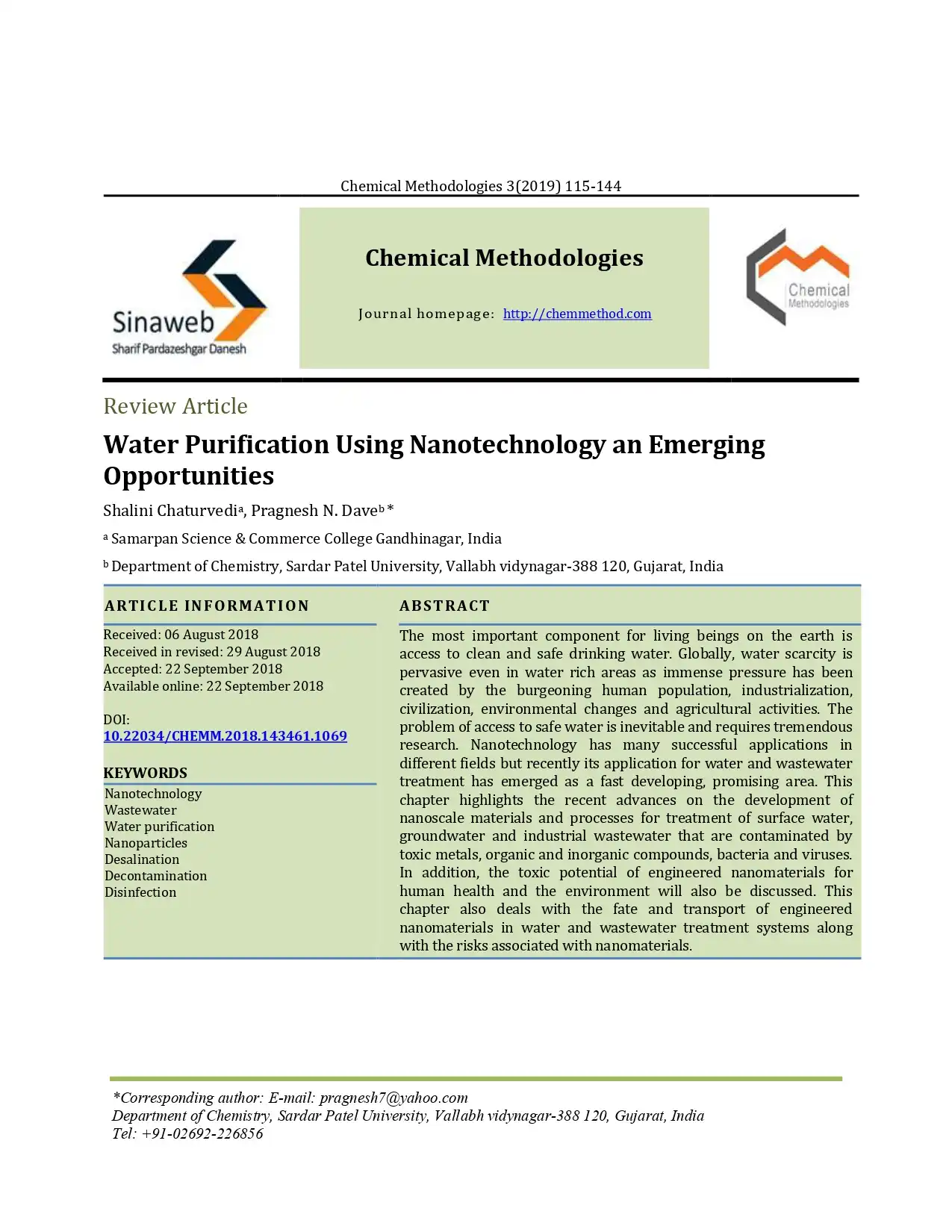Water Purification Using Nanotechnology an Emerging Opportunities
Abstract : The most important component for living beings on the earth is access to clean and safe drinking water. Globally, water scarcity is pervasive even in water rich areas as immense pressure has been created by the burgeoning human population, industrialization, civilization, environmental changes and agricultural activities. The problem of access to safe water is inevitable and requires tremendous research. Nanotechnology has many successful applications in different fields but recently its application for water and wastewater treatment has emerged as a fast developing, promising area. This
chapter highlights the recent advances on the development of nanoscale materials and processes for treatment of surface water, groundwater and industrial wastewater that are contaminated by toxic metals, organic and inorganic compounds, bacteria and viruses. In addition, the toxic potential of engineered nanomaterials for human health and the environment will also be discussed. This chapter also deals with the fate and transport of engineered
nanomaterials in water and wastewater treatment systems along with the risks associated with nanomaterials.
Water Purification Using Nanotechnology an Emerging Opportunities
Abstract : The most important component for living beings on the earth is access to clean and safe drinking water. Globally, water scarcity is pervasive even in water rich areas as immense pressure has been created by the burgeoning human population, industrialization, civilization, environmental changes and agricultural activities. The problem of access to safe water is inevitable and requires tremendous research. Nanotechnology has many successful applications in different fields but recently its application for water and wastewater treatment has emerged as a fast developing, promising area. This
chapter highlights the recent advances on the development of nanoscale materials and processes for treatment of surface water, groundwater and industrial wastewater that are contaminated by toxic metals, organic and inorganic compounds, bacteria and viruses. In addition, the toxic potential of engineered nanomaterials for human health and the environment will also be discussed. This chapter also deals with the fate and transport of engineered
nanomaterials in water and wastewater treatment systems along with the risks associated with nanomaterials.
Debottlenecking Water-Oil Separation with Increasing Water Flow Rates in Mature Oil Fields
•Maturing fields with increasing water flow rates
•For certain GOSPs, water-oil separator (WOSEP) is the bottleneck
•WOSEPs are reaching capacity to process oily produced water
•Need solution to debottleneck gas-oil separation plant for forecast rates
-Quantify separation performance
-Apply enhanced internal technology to improve separation at higher throughputs
Debottlenecking Water-Oil Separation with Increasing Water Flow Rates in Mature Oil Fields
•Maturing fields with increasing water flow rates
•For certain GOSPs, water-oil separator (WOSEP) is the bottleneck
•WOSEPs are reaching capacity to process oily produced water
•Need solution to debottleneck gas-oil separation plant for forecast rates
-Quantify separation performance
-Apply enhanced internal technology to improve separation at higher throughputs
Water Treatment Lecture 3: Coagulation and Flocculation
Coagulation and flocculation are two consecutive process (i.e. occur one after the other) that are used to remove colloidal particles from water.
Colloids are very small particles (turbidity and color causing particles) that can not be removed neither by sedimentation (due to their light weight) nor by filtration.
Water Treatment Lecture 3: Coagulation and Flocculation
Coagulation and flocculation are two consecutive process (i.e. occur one after the other) that are used to remove colloidal particles from water.
Colloids are very small particles (turbidity and color causing particles) that can not be removed neither by sedimentation (due to their light weight) nor by filtration.
Water Treatment Lecture 2: Aeration
Aeration is used for many purposes in water Treatment , the main uses are:
1. Increase the dissolved oxygen concentration in water.
2. Decrease CO2 concentration thereby reduce its corrosiveness.
3. Reduce taste and odor caused by dissolved gases such as Hydrogen sulphide (H2S) and methane (CH4) that are removed during aeration.
4. Oxidize iron and manganese from their soluble to insoluble states and cause them to precipitate so that they maybe removed by sedimentation and filtration processes.
5. Remove certain volatile organic compounds.
Water Treatment Lecture 2: Aeration
Aeration is used for many purposes in water Treatment , the main uses are:
1. Increase the dissolved oxygen concentration in water.
2. Decrease CO2 concentration thereby reduce its corrosiveness.
3. Reduce taste and odor caused by dissolved gases such as Hydrogen sulphide (H2S) and methane (CH4) that are removed during aeration.
4. Oxidize iron and manganese from their soluble to insoluble states and cause them to precipitate so that they maybe removed by sedimentation and filtration processes.
5. Remove certain volatile organic compounds.










